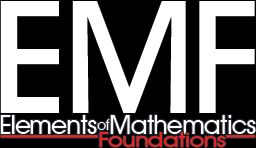The Barrington Community Unit District 220 (District 220) Extended Math Program partners with Elements of Mathematics: Foundations (EMF) to support children with a unique profile of strengths, talents, and/or abilities whose needs exceed the core curriculum. EMF is the most advanced secondary school mathematics curriculum available today.
District 220 students who complete 8th grade Extended Math will receive a high school credit for Algebra 2.
EMF is developed by the Institute for Mathematics & Computer Science (IMACS).


